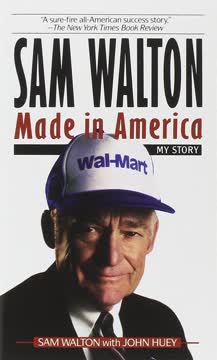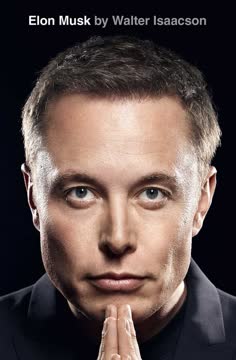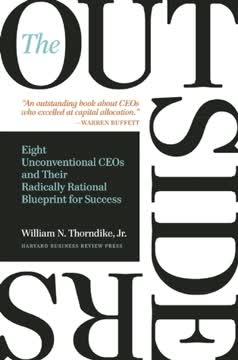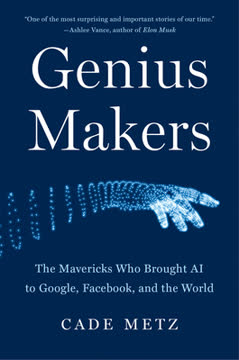Key Takeaways
1. Bill Gates: A prodigy with an entrepreneurial spirit from an early age
"If anybody wants to know why Bill Gates is where he is today, in my judgment it's because of this early experience cutting deals."
Early signs of genius. Bill Gates showed exceptional aptitude for mathematics and computers from a young age. At Lakeside School, he developed a passion for programming and began exploring the commercial potential of his skills. Gates' competitive nature and business acumen were evident even in his teenage years, as he negotiated deals and sought opportunities to monetize his talents.
Formative experiences. Key events shaped Gates' future:
- Exposure to computers at Lakeside School
- Founding the Lakeside Programmers Group
- Creating Traf-O-Data, his first business venture
- Working at Computer Center Corporation (C-Cubed)
- Meeting and partnering with Paul Allen
These experiences not only honed Gates' technical skills but also developed his entrepreneurial mindset, laying the foundation for his future success with Microsoft.
2. Microsoft's humble beginnings: From BASIC to industry leader
"We Set the Standard"
From BASIC to empire. Microsoft's journey began with Gates and Allen's development of BASIC for the Altair 8800. This initial success led to:
- Partnerships with multiple computer manufacturers
- Expansion into other programming languages
- Development of the MS-DOS operating system
- Creation of application software like Multiplan and Word
Strategic growth. Microsoft's rapid ascent was driven by:
- Focus on becoming the industry standard
- Aggressive pursuit of OEM deals
- Expansion into international markets, particularly Japan
- Diversification of product offerings
- Recruitment of top talent in programming and management
The company's ability to anticipate market trends and quickly adapt to changing technologies positioned it as a leader in the rapidly evolving personal computer industry.
3. The pivotal IBM deal: How Microsoft secured the DOS operating system
"Gates decided the best thing he could do to stop people from stealing his software was to strike back publicly at the thieves."
A game-changing opportunity. When IBM approached Microsoft for an operating system for their new personal computer, Gates and Allen seized the moment. Key aspects of this pivotal deal included:
- Microsoft's acquisition of QDOS (Quick and Dirty Operating System) from Seattle Computer Products
- Adaptation of QDOS into MS-DOS for IBM
- Retaining the rights to sell DOS to other computer manufacturers
Long-term impact. This deal had far-reaching consequences:
- Established Microsoft as a major player in the software industry
- Provided a steady revenue stream from DOS licensing
- Positioned Microsoft to become the dominant force in PC operating systems
- Set the stage for future conflicts with competitors like Digital Research
The IBM deal showcased Gates' business acumen and ability to negotiate favorable terms, setting Microsoft on a trajectory to dominate the personal computer software market.
4. Windows: A rocky start but a game-changing vision
"Windows was a pig."
A challenging development. The creation of Windows was fraught with difficulties:
- Numerous delays and missed deadlines
- Technical challenges in creating a graphical user interface for PCs
- Internal conflicts and management issues
- Competition from other companies developing similar products
Persistence pays off. Despite initial setbacks, Gates' commitment to the Windows concept eventually bore fruit:
- Continuous improvement of the product through multiple versions
- Gradual adoption by users and software developers
- Evolution into the dominant operating system for personal computers
- Realization of Gates' vision for a more user-friendly computing experience
The development of Windows demonstrated Microsoft's ability to persevere through challenges and ultimately shape the future of personal computing.
5. Microsoft's aggressive business tactics and legal battles
"These guys [Microsoft] play hardball. They grind people. It almost doesn't make good business sense."
Competitive strategies. Microsoft's rise to dominance was marked by aggressive tactics:
- Undercutting competitors' prices
- Leveraging its position to enter new markets
- Using its influence to shape industry standards
- Engaging in hard-nosed negotiations with partners and competitors alike
Legal challenges. The company's practices led to numerous legal battles:
- Disputes over software licensing and ownership
- Antitrust investigations and lawsuits
- Copyright infringement claims from competitors like Apple
These conflicts highlighted the cutthroat nature of the software industry and Microsoft's determination to maintain its market position at all costs.
6. The evolution of Microsoft's corporate culture and work ethic
"If you wanted to be around him, you worked with him."
Intense work environment. Microsoft's culture was characterized by:
- Long hours and demanding schedules
- High expectations for employee performance
- A focus on technical excellence and innovation
- Informal dress code and office atmosphere
Attracting top talent. The company's approach to recruitment and retention included:
- Offering stock options to employees
- Creating a college-like campus environment
- Encouraging a balance of hard work and play
- Fostering a sense of being part of something revolutionary
This unique culture helped Microsoft attract and retain some of the brightest minds in the industry, fueling its rapid growth and innovation.
7. Gates' leadership style: Competitive, confrontational, and visionary
"Gates could be just apoplectic over things. ... that was just the emotional level he reacted to things on."
Intense and demanding. Gates' leadership was characterized by:
- High expectations for himself and others
- Direct and often confrontational communication style
- Ability to grasp complex technical and business issues quickly
- Willingness to challenge and debate ideas at all levels
Visionary thinking. Despite his sometimes abrasive style, Gates was respected for:
- His ability to anticipate industry trends
- Strategic thinking that positioned Microsoft for long-term success
- Commitment to pushing the boundaries of technology
- Willingness to take calculated risks
Gates' leadership style, while controversial, was instrumental in driving Microsoft's growth and shaping its corporate culture.
8. Microsoft's public offering: A milestone in the company's growth
"Is this a distraction?"
A reluctant decision. Gates initially resisted taking Microsoft public, concerned about:
- Potential distractions for employees
- Loss of control over the company's direction
- Increased scrutiny from investors and regulators
Successful launch. Despite Gates' reservations, the IPO was a resounding success:
- Stock price soared on the first day of trading
- Created numerous millionaires among Microsoft employees
- Provided capital for further expansion and acquisitions
- Solidified Microsoft's position as a major player in the tech industry
The public offering marked a new chapter in Microsoft's history, bringing both opportunities and challenges as the company transitioned from a private to a public entity.
9. The challenges of partnership: Microsoft's complex relationship with IBM
"It was a clash of two companies at opposite ends of the spectrum."
Cultural differences. The Microsoft-IBM partnership was marked by stark contrasts:
- Microsoft's informal, fast-paced culture vs. IBM's corporate bureaucracy
- Differences in decision-making processes and project management
- Conflicting visions for the future of personal computing
Joint development challenges. The collaboration on OS/2 faced numerous obstacles:
- Disagreements over technical specifications and features
- Delays in product development and release
- Shifting market dynamics that affected the project's viability
The partnership highlighted the difficulties of collaboration between companies with vastly different cultures and approaches to innovation.
10. Apple vs. Microsoft: The landmark lawsuit that shook the industry
"Apple is using the press to send a message. The suit is supposed to strike fear into people's hearts and make them think that Apple invented this stuff and not Xerox."
Legal battle over GUI. Apple's lawsuit against Microsoft centered on:
- Claims of copyright infringement in Windows' graphical user interface
- Disputes over the interpretation of previous licensing agreements
- Broader implications for software development and innovation
Industry-wide impact. The lawsuit had far-reaching consequences:
- Created uncertainty in the software development community
- Highlighted the complex issues of intellectual property in software
- Strained relationships between key players in the tech industry
- Potentially threatened the development of graphical interfaces for PCs
This legal battle underscored the high stakes and fierce competition in the rapidly evolving personal computer industry, with significant implications for the future of software development and user interfaces.
Last updated:
FAQ
What's Hard Drive: Bill Gates and the Making of the Microsoft Empire about?
- Biography of Bill Gates: The book chronicles Bill Gates' journey from his early years to becoming the CEO of Microsoft, highlighting his drive and ambition.
- Microsoft's Creation and Rise: It details the founding of Microsoft, the development of key products like MS-DOS and Windows, and the company's strategies in the competitive software industry.
- Human Element: The narrative includes personal anecdotes and testimonies, painting a complex picture of Gates as both a visionary and a controversial figure.
Why should I read Hard Drive: Bill Gates and the Making of the Microsoft Empire?
- Insight into a Tech Icon: The book provides an in-depth look at one of the most influential figures in technology, offering insights into Gates' mindset and work ethic.
- Industry Impact: Understanding Gates' influence on the tech industry can provide insights into current trends and future developments in software and technology.
- Engaging Storytelling: The authors use engaging storytelling techniques, making it a compelling read filled with anecdotes and details.
What are the key takeaways of Hard Drive: Bill Gates and the Making of the Microsoft Empire?
- Drive and Ambition: Gates' relentless pursuit of success and his competitive nature are central themes, illustrating how these traits contributed to Microsoft's growth.
- Innovation and Adaptation: The book highlights the importance of innovation and adapting to market changes as crucial for Microsoft’s success.
- Business Acumen: Gates' ability to negotiate and understand market dynamics is emphasized, showcasing his strategic thinking in building Microsoft.
What are the best quotes from Hard Drive: Bill Gates and the Making of the Microsoft Empire and what do they mean?
- “I can do anything I put my mind to.”: Reflects Gates' confidence and determination, pivotal in his early achievements and the founding of Microsoft.
- “A computer on every desktop, and Microsoft software in every computer.”: Encapsulates Gates’ vision for the future of computing, illustrating his ambition to make technology accessible to everyone.
- “Bill knows what he’s doing. He’s thought it out.”: Highlights Gates' strategic thinking and planning abilities, suggesting his success is the result of careful consideration and execution.
How did Bill Gates and Paul Allen meet according to Hard Drive: Bill Gates and the Making of the Microsoft Empire?
- Childhood Friends: Gates and Allen met as teenagers at Lakeside School in Seattle, bonding over their shared interest in computers and programming.
- Collaborative Projects: Their early collaboration included projects like Traf-O-Data, laying the groundwork for their future partnership in founding Microsoft.
- Shared Vision: Both had a vision of personal computing that drove them to create software that would eventually revolutionize the industry.
What challenges did Microsoft face in its early years as described in Hard Drive: Bill Gates and the Making of the Microsoft Empire?
- Competition with MITS: The licensing agreement with MITS created limitations for Microsoft, as they were unable to freely market BASIC to other companies.
- Software Piracy Issues: Gates expressed frustration over the widespread piracy of BASIC, which hindered Microsoft's revenue and growth potential.
- Transitioning to a New Market: As the personal computer market expanded, Microsoft had to adapt quickly to new competitors and changing technology demands.
How did Microsoft’s relationship with IBM evolve according to Hard Drive: Bill Gates and the Making of the Microsoft Empire?
- Initial Collaboration: Microsoft’s partnership with IBM began with the development of DOS for the IBM PC, a significant milestone for both companies.
- Tensions and Competition: As Microsoft grew, tensions arose, particularly as IBM sought to develop its own software solutions, leading to a more competitive dynamic.
- Final Split: The relationship deteriorated as Microsoft shifted focus to Windows, leading to a public separation, ultimately benefiting Microsoft.
What role did VisiCalc play in Microsoft’s development according to Hard Drive: Bill Gates and the Making of the Microsoft Empire?
- Catalyst for Application Software: VisiCalc’s success demonstrated the potential of application software, prompting Gates to shift Microsoft’s focus from programming languages to applications.
- Inspiration for Microsoft’s Products: The features and functionalities of VisiCalc influenced the development of Microsoft’s own spreadsheet software, Multiplan.
- Market Awareness: Gates recognized that applications could drive consumer interest in personal computers, leading to Microsoft’s establishment of a consumer products division.
How did Gates’ management style impact Microsoft as described in Hard Drive: Bill Gates and the Making of the Microsoft Empire?
- Confrontational Approach: Gates was known for his intense and often abrasive management style, fostering a culture of urgency but also causing high turnover and burnout.
- Hands-On Leadership: Gates was deeply involved in product development, ensuring high standards but sometimes stifling creativity and autonomy among his team.
- Focus on Results: Gates prioritized results over process, pushing his team to meet ambitious goals, contributing to Microsoft's rapid growth but creating a challenging work environment.
What was the significance of BASIC in Hard Drive: Bill Gates and the Making of the Microsoft Empire?
- Foundation of Microsoft: BASIC was one of the first products developed by Microsoft, marking the company's entry into the software market and establishing its reputation.
- Accessibility for Users: The language was designed to be user-friendly, allowing hobbyists and programmers to easily interact with computers, contributing to the growth of the personal computing movement.
- Commercial Success: The licensing agreements for BASIC with companies like MITS were crucial for Microsoft's early revenue and set the stage for future software development.
What impact did the launch of Windows 3.0 have on Microsoft as described in Hard Drive: Bill Gates and the Making of the Microsoft Empire?
- Market Dominance: The successful launch of Windows 3.0 solidified Microsoft's position as a leader in the software industry, becoming the standard operating environment for personal computers.
- Increased Revenue: Windows 3.0 significantly boosted Microsoft's revenues and profits, contributing to its rapid growth and attracting more developers to the platform.
- Cultural Shift: The launch changed the perception of Microsoft from a struggling software company to a powerhouse in the tech industry, realizing Gates' vision for user-friendly software.
How did Bill Gates' early life influence his career according to Hard Drive: Bill Gates and the Making of the Microsoft Empire?
- Early Exposure to Technology: Gates was introduced to computers at a young age, sparking his interest in programming and providing him with rare access to technology.
- Competitive Spirit: Gates' competitive nature was evident even in his youth, driving him to outdo his peers and later manifesting in his business practices at Microsoft.
- Supportive Environment: Gates' family encouraged his interests, providing resources and support to pursue his passion for technology, playing a crucial role in shaping his future success.
Review Summary
Hard Drive is widely praised as an insightful biography of Bill Gates and the early days of Microsoft. Readers appreciate the detailed account of Gates' childhood, his relentless work ethic, and his ruthless business tactics. The book provides a comprehensive look at the personal computer industry's evolution and Microsoft's rise to dominance. While some find the technical details overwhelming, most consider it a fascinating read that demystifies Gates' success. However, being published in 1992, it misses later developments in Microsoft's history.
Similar Books










Download PDF
Download EPUB
.epub digital book format is ideal for reading ebooks on phones, tablets, and e-readers.




